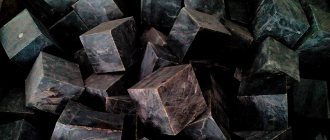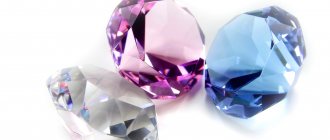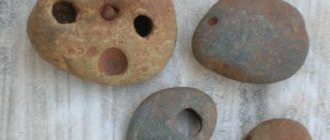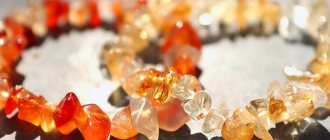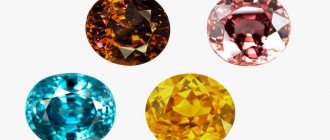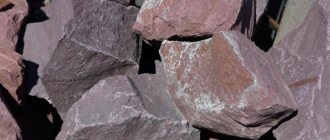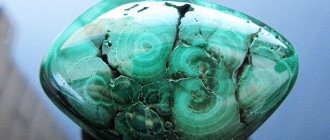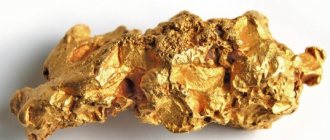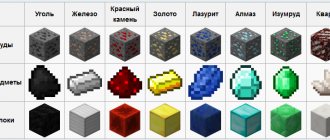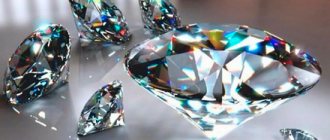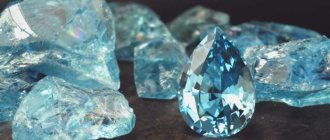In this article we will talk about the color of precious and semi-precious stones and the reasons for its occurrence. The information provided about the factors influencing the observed color and its components will help when buying or selling natural cut specimens and will be useful when evaluating. You will also learn the main reasons that cause the appearance of additional shades in gems. And information about the influence of a specimen’s color on its value can help in understanding the structure of the precious stones market.
In the photo: color varieties of the beryl mineral: aquamarine (blue), peachy pink morganite and golden yellow heliodor
Color is the most important characteristic of any stone. Of all the quality parameters, it is the color that most strongly influences the overall attractiveness and cost of the gemstone. Color is also an important diagnostic feature when identifying gems. The quality of colored natural jewelry stones is assessed by gemstone specialists - gemologists.
The main reason for the appearance of color
In the photo: top red ruby, 4.06 carats, Burma
The main reason for the appearance of color is the ability of the gemstone to selectively absorb light rays from the white light spectrum. The main components that shape a person’s perception of color are light, stone and the observer himself. White light contains all spectral components (i.e. all the colors of the rainbow).
Each color corresponds to a specific wavelength. When the light reaches the stone, part of the spectrum of white light is absorbed, and the totality of the light waves passing through the stone returns to the eye of the observer and causes the sensation that he sees. If a gemstone completely absorbs all wavelengths, it will appear black. If it completely reflects (or transmits) light, then it is perceived by the observer as white or colorless. A stone that absorbs light only at certain wavelengths appears to be a specific color to the observer.
Example
Let's look at this with an example. We perceive the color of a ruby as red, because... The stone absorbs green, blue and violet rays from light, and transmits only red, orange and yellow ones. When the rays passing through the ruby reach the eyes of the observer, the human brain combines them and interprets them as red.
Unusual coloring of a plaster product
Painting artificial stone can be a creative process:
Under old marble
We keep it in a dark room for 48 hours.
To get the effect of old marble, you can use the following painting technology:
- We buy plaster facing material;
- We keep it in a dark room for 48 hours;
- We heat the drying oil - to protect your hands, you need to use special gloves;
- We cover the tiles with hot drying oil, using a flat brush, it is better to apply the coating in two layers - we treat the surface evenly, without missing unpainted areas.
When the drying oil dries, the gypsum tile will be covered with colored veins that perfectly imitate antique marble. Such products have found their use in finishing kitchens, fireplaces, and so on.
Creating a bronze sheen
You can also do a bronze tint when painting gypsum tiles yourself:
- To begin with, a layer of heated drying oil is applied to the gypsum products. It will take at least 8-10 hours to dry them;
- Next, you need to make a mixture of bronze powder and varnish - we apply this material to plaster products in 2 layers;
- Leave the material to dry;
- Mix 100 ml of acetic acid and 10 g of silver nitrate in 300 g of water;
- We apply dry bronze powder to dried artificial stones and cover it with a vinegar solution on top - such ingredients on the surface of the facing material trigger an oxidation reaction;
- Gently wipe the finished stones with a piece of velvet.
Stain in combination with gypsum also allows you to get a beautiful surface.
Using stain
Stain in combination with gypsum also allows you to get a beautiful surface. It is good to apply stain with a spray gun, but the best effect is obtained by dipping gypsum products into the solution. The stain needs to be warmed up a little and the plaster is lowered into it for a few seconds. After this, it is enough to dry the facing material to obtain a finish in brown tones.
Whatever you choose, you need to first train in a small area - this will allow you to evaluate the final result and adjust your efforts. The final stage of painting can be washing and drying the products - this is important for acid paints. You can also complete the decor of artificial cladding with hydrophobic impregnation - all you have to do is wait for all the layers to dry and evaluate the result.
The influence of lighting and external factors on the observed color of the stone
The influence of lighting and external factors on the observed color of a mineral can be quite significant. The type of lighting itself (its color temperature) has a great influence on the color of the sample visible to the observer. So fluorescent lamps (white light) emit more blue, violet and green rays, which enhance the corresponding colors in the stones. And incandescent light (yellow light) contains more red, orange and yellow rays, so stones of the same colors will look better under that light. So for this reason, when selling red rubies, sellers often light the display case with lamps that produce yellow light, while the display case with blue sapphires will be illuminated by fluorescent lamps (white light). This factor of visual color enhancement depending on the type of lighting must be taken into account when purchasing stones. The standard lighting for color assessment is gemological lamps with daylight (365 nm).
On video: blue sapphire in different lighting. Incandescent light produces a purple tint
Finishing surfaces
The composition of the stone coating is developed by specialists, taking into account maximum compatibility with the majority of popular building materials, including:
- various types of plastered surfaces;
- various surfaces made of concrete and foam concrete;
- composite materials;
- plastic materials;
- tree;
- drywall;
- glass surfaces;
- tile surfaces;
- metal;
- ceramics;
- polyurethane.
In some cases, when creating a landscape design, it is necessary to paint crushed stone or other material that remains after construction.
How to describe the color of a gemstone
To describe the color of a jewelry stone, its color, gemologists can use various standards. In this case, it is customary to indicate three main components of color:
- Color tone
- lightness
- saturation.
Hue is a characteristic of color that determines its correspondence to pure spectral radiation. This is a visual impression. In this case, the main tone and an additional shade (for example, orange, yellowish-orange) are described. The most highly valued are colored jewelry stones, the color of which is as close as possible to the pure spectral color, without additional shades.
In the photo: zircons from Cambodia. The color of the upper specimens is valued approximately twice as much as the lower ones, because it is more saturated and not as light.
Lightness is a color characteristic determined by the ability of a stone to absorb or reflect light radiation. It describes the position of a stone's color on a scale from dark to light. If a stone intensively absorbs the light radiation incident on it, it looks dark; if it absorbs weakly and mainly reflects, it looks light. Example: The color may be described as dark greenish blue or medium greenish blue, light greenish blue.
Saturation is the strength or intensity of the perception of a color tone, the brightness of a color. For example, “pale red” is a red of low saturation, and “bright red” is a red of high saturation.
Materials and tools
In order for painting to go quickly and successfully, you must first prepare the tools required for the job. These include:
- sandpaper;
- rubberized sponge;
- cotton rag;
- spray gun;
- file for grinding;
- degreasing solution;
- brush;
- dye;
- compressor;
- suspension for impregnation.
This decorative coating is often used to decorate landscapes or for finishing houses. Therefore, you need to carefully choose paint.
Additional colors
Additional colors other than the base color may appear in some stones for various reasons. Let's look at the main reasons that cause the appearance of additional colors:
- Color change effect
- Pleochroism
- Window
- Color zoning
Color change effect
Color change effect is an optical effect when two colors are observed in daylight and incandescent light. The primary color is the one visible under a fluorescent lamp, and the secondary one under an incandescent lamp. The intensity of the color change is defined as weak, moderate and strong. Alexandrite has a color-changing effect, changing color from green (in daylight) to red (in incandescent light). This effect can also manifest itself in some garnets, spinels, corundums and other minerals.
In the photo: a garnet with a color changing effect under the daylight of a gemological lamp (left) and under the “yellow” light of a flashlight (right), 11.30 carats
Pleochroism
Pleochroism is a property of a transparent mineral in which a change in color can be seen depending on the direction of observation. The color of pleochroism is assessed if it is visible from the side of the stone platform. The intensity of pleochroism is assessed as weak, moderate and strong. Strong pleochroism is characteristic, for example, of tourmalines and tanzanites.
In the photo: observation of pleochroism colors in tanzanite through a special instrument - a dichroscope
In the photo: observation of pleochroism colors in faceted rubellite
Window
A window is an area of pale color that can be found in the center of a cut specimen if the correct proportions of the cut are not maintained. In this case, light “leaks” through the edges of the pavilion. Additional color is assessed if the size of the “window” is more than 50% relative to the area of the stone. Instances with a large “window” do not look very attractive, and their cost is lower.
In the photo: due to the shallow depth of the pavilion, a pale “window” has formed in the center of the yellow sapphire
Color zoning
Color zoning is an uneven distribution of color that is noticeable when viewed through a stone surface. The stone can be specially cut so that when viewed from the site, areas of different colors are visible. This is typical, for example, for ametrines and polychrome tourmalines. But for many stones, the presence of color zoning, visible from the side of the stone platform in the form of alternating light and saturated areas, will be considered a disadvantage, and then it reduces the cost. Unevenness of color can be expressed in the form of spotting in sapphires, rubies, emeralds, etc.
In the photo: sapphire from Sri Lanka. If the sapphire were a uniform blue, it would cost more
In the photo: polychrome tourmaline from Mozambique. The presence of differently colored color zones in this stone does not reduce its value
In the video: polychrome tourmaline, correctly oriented color zoning from pink to green makes it more attractive
Plaster painting
If desired, gypsum materials can be given a completely unimaginable look, including imitating naturalness (for example, wood).
Various technologies of toning, coloring, and “aging” are used here. Marble tinting. A well-dried gypsum product is impregnated with heated drying oil or shellac-rosin alcohol solution. The impregnation adheres well, without streaks, creating protection against moisture. Gradually the dried primed surface becomes similar to aged marble.
Thanks to tinting, gypsum decor easily imitates marble
Wax tinting. An impregnation is used, consisting of wax dissolved in turpentine (gasoline) with a slight addition of yellow oil paint. After the impregnation dries, the surface is rubbed until glossy.
Ivory-like tinting. A soap maker, nitro varnish and a little yellow oil paint are used. The surface is given a matte finish by rubbing with talcum powder.
Patination. Various shades of brown or brown-green are selected and mixed with other substances. It is recommended to paint in three layers, and in the recesses the treatment is usually carried out with a mixture of a more viscous consistency. The technology of applying the dye is also important here:
- the first layer is lighter, after which it is lightly sanded and wiped with acetone;
- the second layer – the coloring mixture is darker and thicker;
- third layer - to give it a matte finish, a little wax is dissolved in the paint.
The following additives will help to shade or enhance the imitation: bronze powder, talc and chromium oxide, graphite powder, sienna, ocher, umber, soot, green cobalt, lead or zinc white. These are all semi-professional methods of painting gypsum-based materials. Traditional plaster paints are available for sale.
The most commonly used paint mixtures for interior work are acrylic water emulsions or dispersions. After drying, they create a durable protective film that protects the base from moisture. In addition, all water-based paints are environmentally friendly, which means they can be used inside any premises, including residential ones.
When making decorative brick or stone based on gypsum, the working solution is tinted. For this, various powder pigments are used. Tinting the mortar makes it possible to obtain finished bricks that are uniformly colored throughout the entire structure (then operational defects will be less noticeable).
To create an imitation of texture (veins), paints of several shades of color are used. And a finishing varnish coating will help increase the protection of the surface of gypsum brick or stone (after all, gypsum is quite fragile by nature).
Experts advise not to delay painting gypsum finishing elements, as the adhesive properties of the materials deteriorate over time. If this happens, then it’s a good idea to use a primer, and only then paint. The primer will also increase the strength of the gypsum base and create some protection against moisture penetration.
Construction plaster offers unlimited possibilities for original interior decoration. Widespread availability and ease of use have made the material very popular. And having in your arsenal paints, miniums, varnishes, gold leaf and other pigment substances, you can achieve real palace luxury.
Properties of chameleon gems
Stones that change color attracted not only fashionistas and naturalists. They were studied by astrologers who tried to establish the effect of these unusual minerals on humans. Moreover, natural sciences in the Middle Ages could not give accurate answers to all questions. Various hypotheses arose, sometimes fantastic, and sometimes having a rational grain.
It was believed that changing the shade of aquamarine depended on changes in a person’s mood. And pyrope is capable of changing its color to a duller one when the person wearing it is physically and mentally exhausted.
According to astrologers, all natural gems have magical properties:
- alexandrite , changing color, predicts significant changes and brings good luck;
- pomegranate lifts your spirits and strengthens self-confidence, helps you achieve your goals, and protects family happiness;
- fire opal protects against the evil eye, develops clairvoyance abilities, strengthens the mind;
- tourmaline protects from enemies, attracts success, develops creativity;
- sapphire is a stone of good luck and prosperity, protects against the evil eye, strengthens the spirit, attracts wealth;
- moonstone protects love, cleanses a person’s aura and removes negative emotions;
- amethyst - reveals hidden talents, promotes harmony in love.
Buy or make it yourself?
Manufacturers have developed many types of finishing materials. Gypsum bricks for interior decoration are presented in various modifications in catalogs:
- The glossy varnished version is fashionable.
- The matte muted look, which is treated with a protective compound, is interesting.
- Models with a flat surface, embossed or curved are equally in demand.
There are gypsum blocks on sale that replicate hewn stone segments or irregularly shaped minerals, but the easiest to use is an imitation of brickwork.
The entire spectrum of beige colors, shades of gray, brown, and sand are in demand. Many consumers prefer the color of natural brick or simple white. A colorless surface can be painted with selected paint. To the touch, decorative gypsum material can be smooth, structured or rough.
If desired, a home craftsman can make a lightweight and stable stylized brick himself. This process is quite labor-intensive and requires strict adherence to the recipe and the availability of suitable containers for filling the composition. Experts advise using commercially available silicone molds.
The main ingredients for creating such a finishing material will be: gypsum itself and PVA construction adhesive. If desired, a decorative color or pigment can be used; a white version can be formed. To prepare a solution of the required consistency, water is added when mixing the components.
For 1 kg of dry powder you will need approximately 0.5 liters of liquid and about 50 g of PVA. You can add polypropylene fiber for reinforcement: you will need 1-2 g of it per kilogram of gypsum base.
The required amount of dry matter is gradually poured into the container, water and glue are also added gradually. The resulting “dough” is stirred until smooth, resulting in a composition reminiscent of 25% sour cream.
To stimulate the setting process, some craftsmen add citric acid to the solution: about 0.5 g per standard bucket. The coloring pigment is first diluted in water and added to the total mass at the end of the preparation process.
The molds can be greased with petroleum jelly or treated with soapy water. The mixture is poured in one layer and after half an hour the decorative “masterpiece” becomes solid. It is recommended to coat finished products with an acrylic primer.
